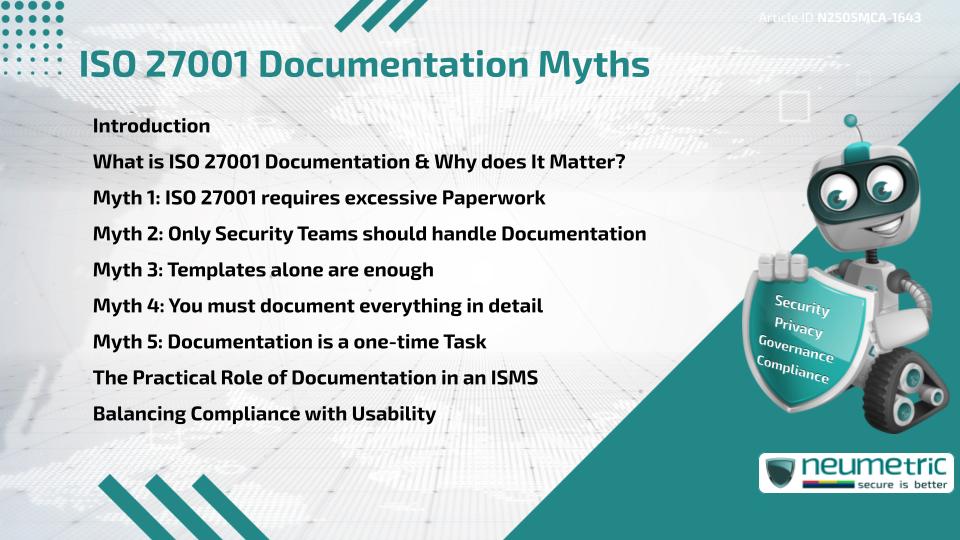Table of Contents
ToggleIntroduction
When Organisations pursue ISO 27001 Certification, one common area of confusion is Documentation. Misconceptions about what must be documented & how much effort it takes can overwhelm even Experienced Teams. These ISO 27001 Documentation myths often lead to wasted time, unnecessary complexity & even failed audits.
This article breaks down the most common myths around ISO 27001 Documentation, explains why they persist & clarifies what is actually expected. Whether you are part of an Information Security Team or a general Business Stakeholder, understanding the truth behind these myths can make your path to Compliance far smoother.
What is ISO 27001 Documentation & Why does It Matter?
ISO 27001 is an International Standard that sets out the criteria for an Information Security Management System [ISMS]. The Documentation requirement exists not just to satisfy Auditors but to ensure your Security Controls are understood, repeatable & effective.
Documentation provides clarity, supports Employee Training & proves that your Organisation takes Data Protection seriously. It also forms the basis of Continuous Improvement. However, confusion arises when Organisations equate Documentation with Bureaucracy.
Myth 1: ISO 27001 requires excessive Paperwork
A common misconception is that ISO 27001 demands stacks of Policy Manuals, Procedures & Forms. This often stems from outdated Implementation Practices or overuse of generic Templates.
In reality, the Standard allows for flexibility. You are only required to document what is necessary to ensure effective control. Annex A of ISO 27001 provides a list of suggested Controls, but not all are mandatory.
The intent is practicality, not paperwork. The focus should be on meaningful Documentation that supports your processes, not on volume.
Myth 2: Only Security Teams should handle Documentation
While Security Professionals often lead ISO 27001 Projects, effective Documentation involves many roles. HR, Legal, IT, Operations & even Marketing can be responsible for relevant Policies.
For example, an Acceptable Use Policy may need input from HR while an Incident Response Plan involves both IT & Management. By isolating Documentation within Security Teams, Organisations Risk creating impractical or misaligned Documents.
Myth 3: Templates alone are enough
Templates can be a helpful starting point, especially for first-time implementers. However, relying on them without tailoring the content to your actual Business processes can lead to major Compliance Gaps.
For example, a generic Access Control Policy Template might assume you use specific Technologies or Roles you do not have. Worse, Auditors may penalise you for maintaining Documents that do not reflect your real environment.
Documentation should reflect your Organisation. Avoid copy-pasting documents without Review.
Myth 4: You must document everything in detail
Another common myth is that every Policy or Control must be written in extensive detail. ISO 27001 requires Documentation only where it adds value or is necessary to demonstrate conformity.
You can often meet the Requirements using concise, high-level Documentation. For instance, a Password Policy does not need to list every possible password but rather define clear Rules & Responsibilities.
Myth 5: Documentation is a one-time Task
ISO 27001 Documentation must be maintained, reviewed & updated regularly. Treating it as a one-and-done project can lead to Audit Failures or Overlooked Risks.
Businesses evolve. Technologies change. Regulations shift. A static document will not reflect those changes. Regular Internal Audits & Management Reviews are essential.
The Practical Role of Documentation in an ISMS
Documentation is not just about passing an Audit. It helps in:
- Communicating expectations across Teams
- Reducing dependency on specific Employees
- Supporting Evidence during Incidents or Legal Reviews
- Building a foundation for Continuous Improvement
Viewed from this lens, ISO 27001 Documentation becomes a strategic asset rather than a chore.
Balancing Compliance with Usability
Balance between completeness & usability is a striking challenge. Overly complex Documentation may technically meet requirements but be ignored in practice.
Keep Policies readable & use plain language. Limit length to what Staff will realistically read. Version Control & easy Access also matter.
A short, clear document read by all is more valuable than a long one read by none.
Common Documentation Mistakes to Avoid
Avoiding these common pitfalls can improve your Documentation quality:
- Using outdated Templates
- Forgetting to assign document Owners
- Ignoring User feedback
- Creating documents that contradict actual practices
- Failing to maintain Version Control
The goal is not perfection, but relevance & clarity.
Takeaways
- ISO 27001 Documentation myths can lead to Overcomplication, Wasted Time & Failed Audits.
- Not everything needs to be documented or overly detailed.
- Cross-functional collaboration improves document relevance & accuracy.
- Templates are useful but must be tailored to your context.
- Documentation should be maintained, not just created once.
- Concise, clear & usable Documentation is more effective than exhaustive Records.
FAQ
What are the most common ISO 27001 Documentation myths?
Common myths include thinking that excessive paperwork is required, that only Security Teams are responsible or that Templates are sufficient.
Do I need to document every ISO 27001 control?
No. You only need to Document Controls that are applicable & necessary for your ISMS. Documentation should reflect what you actually do.
Can Templates be used for ISO 27001 Documentation?
Yes, but they should be customised. Using an unmodified Templates is one of the more persistent ISO 27001 Documentation myths.
Who should be responsible for Documentation?
Multiple Departments should contribute. Isolating Documentation within IT or Security Teams can limit its accuracy & effectiveness.
Is maintaining ISO 27001 Documentation a continuous process?
Yes. It should be reviewed & updated regularly to reflect changes in Business, Technology or Regulation.
Are Policies enough to pass an Audit?
Not always. You need supporting Procedures & Evidence that Policies are being followed. Auditors look for proof of Implementation.
How can I keep Documentation User-friendly?
Use clear language, avoid jargon, apply formatting for readability & limit unnecessary detail. Make access & updates simple.
What happens if I follow Documentation that does not reflect reality?
This could lead to Audit Failure or Security Risks. Your Documentation must align with actual Practices.
Need help?
Neumetric provides organisations the necessary help to achieve their Cybersecurity, Compliance, Governance, Privacy, Certifications & Pentesting goals.
Organisations & Businesses, specifically those which provide SaaS & AI Solutions, usually need a Cybersecurity Partner for meeting & maintaining the ongoing Security & Privacy needs & requirements of their Clients & Customers.
SOC 2, ISO 27001, ISO 42001, NIST, HIPAA, HECVAT, EU GDPR are some of the Frameworks that are served by Fusion – a centralised, automated, AI-enabled SaaS Solution created & managed by Neumetric.
Reach out to us!


